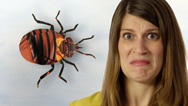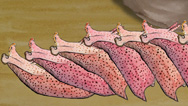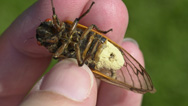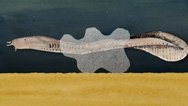Hidden Secrets of Poop Fossils
- By Anna Rothschild
- Posted 08.06.15
- NOVA
Fossilized poop, called coprolites, can reveal surprising secrets about the past. Find out more in this episode of Gross Science.
Transcript
Hidden Secrets of Poop Fossils
Posted: August 6, 2015
What if, thousands of years from now, all that was left of you…was your poop?
I’m Anna Rothschild, and this is Gross Science.
Every poop is a nugget of information. Poop records what we eat, where we live, even how we died. So when archaeologists find the fossilized poop of ancient humans, they get kind of excited.
These poop fossils are called coprolites, and they’re pretty rare. Although we make a lot of them, feces are tough to preserve.
But there are a few ways poop manages to stick around for posterity. It can dry out—in caves or in a mummy’s desiccated intestines. Particularly impressive poops can leave dents in the earth that get filled in—creating a cast and mold of the ancient bowel movement. And a turd can also turn to stone, when minerals in water slowly permeate and replace the molecules in the turd.
Whatever else was in the poop gets mineralized as well. Take this nearly 8-inch, 1000-year-old Viking monstrosity discovered in England. The poor Viking who created this treasure was infested with tons of intestinal parasites like whipworms, which were preserved along with the giant poo, illustrating just how squalid everyday life was back then. And this guy wasn’t an anomaly—archaeologists have also found cesspits (essentially Viking sewers) that were filled with parasite eggs.
Poop can also tell us who was living where. In Puerto Rico, the contents of 1-2 millennia-old coprolites backed up the archaeological evidence that native populations on the island at the time were two distinct cultural groups, with different diets, and different parasites.
Fossilized turds can even shed light on ancient murder mysteries. In Medieval Verona, the warlord Cangrande della Scala—patron of the poet Dante Alighieri—died at the age of 38 after a severe bout of vomiting and diarrhea. Rumors of foul-play spread, though at the time no one could prove it. But nearly 700 years later, researchers dug up the body and analyzed the feces that were preserved in the corpse’s rectum. They found out that he had ingested a poisonous plant before he died. And from the chamomile and mulberry pollen preserved in the poop as well, the researchers surmised that he drank a poisoned tea that killed him.
So the next time you grab your newspaper and head to the bathroom, think about it not so much as going number 2, but as contributing to the archaeological record.
Ew.
Credits
PRODUCTION CREDITS:
- Host, Producer
- Anna Rothschild
- Writer, Animator, Editor, DP, Sound
- Rachel Becker
- Many thanks to Dr. Dennis Jenkins, Dr. Karen Chin, Dr. Hendrik Poinar, Dr. Andrew Knoll, and Dr. Ainara Sistiaga.
- Menu Ouvrier
- Music Provided by APM
IMAGES
- Lloydsbankcoprolite 001
- Wikimedia Commons/ Linda Spashett Storye book
- Stone texture 11
- DeviantArt/enframed
- Cangrande1 (mummy)
- Wikimedia Commons/Gino Fornaciairi
- Cangrande.portrait
- Wikimedia Commons/Frn Brz
- spetti di vita quotidiana, vomito,Taccuino Sanitatis (Vomiting man)
- Wikimedia Commons/Public Domain
- Matricaria recutita (chamomile)
- Wikimedia Commons/Public Domain
- Morus alba Blanco1 (mulberry)
- Wikimedia Commons/Public Domain
SFX
- Cockroaches
- Freesound/StateAardvark
(used with permission from author) - Squeak Pack/squeak_10
- Freesound/Corsica_S
- Groaning gurgle
- SoundsExciting/Public Domain
- Short Fart_01
- DSISStudios/Public Domain
- Pop
- Anagar/Public Domain
- Squelch
- Billox30/Public Domain
- Additional adorable sound effects
- Rachel Becker
- Produced by WGBH for PBS Digital Studios
IMAGE
- (main image: Illustration of Poop Fossil)
- ©WGBH Educational Foundation 2015
Sources
Want more info?
Coprolite preservation and analysis:
University of California Museum of Paleontology:
http://www.ucmp.berkeley.edu/paleo/fossils/coprol.html
Karl Reinhard:
http://digitalcommons.unl.edu/cgi/viewcontent.cgi?article=1043&context=natrespapers
Karen Chin, Paleontological Society Papers, V8 2002:
http://www.yale.edu/ypmip/predation/Chapter_02.pdf
For more on the Lloyds Bank turd from York, UK (Viking coprolite):
http://www.bbc.co.uk/ahistoryoftheworld/objects/51Et55R_RuCmabtTgQllzQ
http://www.buzzfeed.com/alexkasprak/is-this-the-largest-viking-turd-ever-found
http://www.theguardian.com/uk/2003/jun/06/artsandhumanities.arts1
Review paper about plant and animal remains in ancient york:
http://eprints.whiterose.ac.uk/1174/
Coprolites found in Puerto Rico:
Nature News article by Sara Reardon:
http://www.nature.com/news/ancient-faeces-reveal-origins-of-puerto-rican-natives-1.15203
Primary research papers:
http://journals.plos.org/plosone/article?id=10.1371/journal.pone.0106833
http://journals.plos.org/plosone/article?id=10.1371/journal.pone.0065191
Cangrande della Scala’s poison-filled coprolites:
Primary research paper (behind a paywall):
http://www.sciencedirect.com/science/article/pii/S0305440314004580
Discovery news coverage:
http://news.discovery.com/history/archaeology/mummy-poo-solves-700-year-old-murder-mystery-150110.htm
Related Links
-

Gross Science
Bizarre stories from the slimy, smelly, creepy world of science.
-

Sea Slugs' Gigantic Neurons
The California brown sea hare has gigantic neurons. It also has a very strange way of reproducing.
-

Butt-less Cicadas
The fungus Massospora cicadina makes periodical cicadas’ butts fall off.
-

Hagfish Slime Fashion
Scientists think hagfish slime could be the next eco-friendly, high-performance material.

